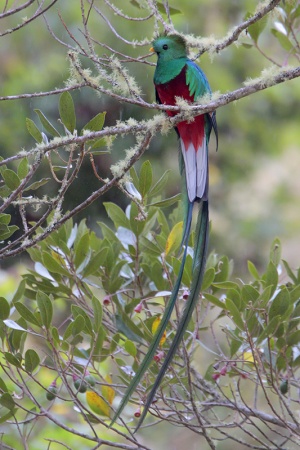(Attempt to disguise copied text. Video link. References) |
|||
| Line 1: | Line 1: | ||
;[[:Category:Pharomachrus|Pharomachrus]] mocinno | ;[[:Category:Pharomachrus|Pharomachrus]] mocinno | ||
| − | [[Image: | + | [[Image:RquetzalBU3J98502 BF.jpg|thumb|550px|right|<br />photo of Male by {{user|Kite|Kite}}<br /> [[Costa Rica]], March, 2011]] |
==Identification== | ==Identification== | ||
36 cm.<br /> | 36 cm.<br /> | ||
Revision as of 00:27, 5 February 2012
- Pharomachrus mocinno
Identification
36 cm.
Male:
- Green body, with green-gold to blue-violet iridescence
- Red breast
- Green upper tail coverts
- Helmet-like crest
- Yellow beak
Female: black bill. She additionally has red limited to the vent area, the breast is grayish-brown. Her tail shows uneven spacing of black barring on the underside, his is pure white.
The juvenile male can easily be mistaken for a female; look for developing red plumage on the breast to distinguish it.
Distribution
Southern Mexico to western Panama, Nicaragua, where it is the national bird, and Costa Rica.
Taxonomy
Subspecies
There are two subspecies[1]:
- P. m. mocinno:
- P. m. costaricensis:
- Montane forests of Costa Rica to western Panama
Habitat
Montane forests.
Behaviour
Diet
The diet includes fruit (especially avocados) and insects (wasps, ants, and larvae), and frogs. Some of these can be seen in the image of a female. These birds sometimes hover while they take the fruit.
Breeding
The nest is placed in a hole, excavated in a rotten tree. The 2 pale blue eggs are incubated by both parents for 18 days (the male during the day; the female at night). Both adults care for the young, which are fed on fruit, berries, insects, lizards, and small frogs. The female may depart before the young are fully fledged.
References
- Clements, JF. 2010. The Clements Checklist of Birds of the World. 6th ed., with updates to December 2010. Ithaca: Cornell Univ. Press. ISBN 978-0801445019. Spreadsheet available at http://www.birds.cornell.edu/clementschecklist/Clements%206.5.xls/view
- Wikipedia
Recommended Citation
- BirdForum Opus contributors. (2024) Resplendent Quetzal. In: BirdForum, the forum for wild birds and birding. Retrieved 3 May 2024 from https://www.birdforum.net/opus/Resplendent_Quetzal
External Links






